Cycles, Circles and Flight: Word investigations based on Jeannie Baker’s ‘Circle ‘
written by Lyn Anderson and Ann Whiting
‘Cycles are everywhere in nature…The life cycles of migratory birds are also driven by the earth’s changing seasons and daylight hours, the latter being a primary cue that impels them to begin their migrations.’ (Pete Mara)

Words are the foundation stones of literature. When we investigate words and their structure, we create a cycle of inquiry, a flow through hypothesizing, researching, circling back to the hypothesis, then revisiting the text. This process forms a cycle of learning and understanding that takes us deeper into both texts and words. It can be equally applied to the youngest of learners and older students, it can occur in a day, over weeks, over a month and is part of a general cycle over a year.
Books and words go together like hand and glove. Embedding word inquiry into our learning environments, entwining books and words, brings an understanding of the sense and order inherent in English orthography and adds a depth to the themes and concepts uncovered. Our quest for understanding takes us full circle.
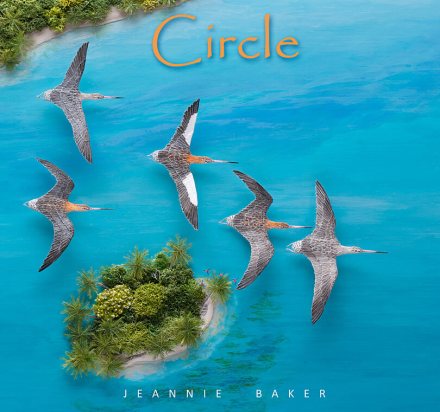
One book that has caught our attention recently is Jeannie Baker’s Circle (2016). The initial page shows a young boy, paralyzed, lying on his bed with his research on the bar-tailed godwit. He dreams of being elsewhere and wishes he could soar with them. Jeannie Baker’s stunning, collaged illustrations reveal the migratory journey of these remarkable birds as they fly full circle … back to ‘a place where mud and sand become sea’.

When working with words we often ask students to capture the essence of the text:
What single word best captures the heart of this story?
We share our word, one person at a time in a ‘whip around’ the room. The vocal sharing conveys an almost poetic sense of the heart of the text.
From these words we select words that are central to the text: cycle, circle and migration. These words provide an opportunity to explore key conventions and principles of English, and to deepen our understanding of themes and issues in the text.
THE CYCLES OF LIFE
Recently Lyn’s reflections on the gracious death and the beautiful birth of close family members, astonishingly falling on the same day, evoked some poignant teaching memories of guiding young children with their study and ultimate discoveries of the ‘cycles of life’.
The cycles of life, the circles of life breathing in every corner of our living world.
Whether it be the study of seasonal changes through the lifeline of trees, an arbour of oaks or chestnuts that swathe us with their crisp fallen leaves and fascinating seeds or the evergreen pine that doesn’t ever seem to change;
or the close scrutiny of the jelly- like membranes of an egg with the excitement of chicks hatching in our organic garden;
or a quest for understanding,“Where does the rain come from?”;
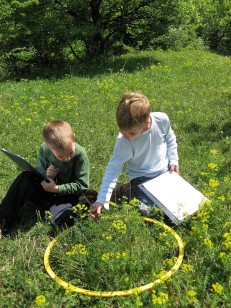
or the sensations of caressing the soft greens and yellows of the mountain meadows;
or the discoveries of the strong, remarkable plants of the hot humid tropics;

or the joy of revealing who we are…the beginning!
All momentous signs of the ‘cycles of life’.
And so we embark on an orthographic journey, concurrently with our deep study of ‘there are many cycles that affect life on earth’.
We really like the word cycles and select this word to study deeply; to investigate its orthography through the three domains of morphology, etymology and phonology.

What is cycle? What is cycle not?
These questions are pondered and deliberated on consistently throughout the study, guiding our quest for understanding.
We revisit the questions often with our students, listening carefully how they communicate and articulate their understanding through the learning experiences that inspire and provoke.
A cycle is not linear, straight or fixed. A cycle is not irregular but may have irregularities as our current weather patterns reveal.
A cycle is circular, constant and infinite. We keep returning to the beginning but is there a beginning point?
‘Cycles are everywhere in nature. They can occur over the length of a day, a season, a year, or longer.’ (Pete Mara)
“A bicycle, that goes round and round…,” exclaims a 4 year old. This leads to an enthusiastic conversation amongst the children as we determine which of the bike’s components goes round and round.
What parts cycle?
Everyone has something to say because bicycles are part of our world.
We plant conceptual ‘learning seeds’ as the children closely inspect the various mechanical parts of the bike. Through close observation the children sketch the bicycle with a range of art materials.
We scribe the children’s thoughts and plant important orthographic ‘learning seeds’ as we announce aloud the orthographic structures of bicycle and bike.
<bi + c-y-c-l- final non syllabic <e>> <b-i-k- final non syllabic <e>>
We talk about our collection of recycled materials to design, create and construct.

We announce aloud the orthographic structure of <re+cycle +ed> as we scribe the children’s thinking. We specifically announce “replace the final non syllabic <e> with the vocalic suffix <-ed>.”
We ask the children to think about the meaning relationship between <recycled> and < cycles>.
Morphological Relatives
Cycles
We begin to discover words that belong in the same family. As we extract words from the word bag the students hypothesize which words may be or may not be in a family. We announce aloud the structure of each word as it is revealed and discussed.
<cycle+s>, <tri+cycle>, <cycle+ing>

The children notice that the words in the bag all share a common base element. We hypothesize <cycle>.

The children illustrate the words collaboratively and our word-web begins to grow, as does the children’s understanding, each time we encounter it.
Later we revisit these words to provide evidence that they do belong in the same family.

The Etymological Story
Stories are made of words and every word has a story.
Cycle, as a noun, was attested in the late 14c. It is derived from Greek kyklos, ‘any circular body, circular motion, cycle of events’, indirectly via Late Latin cyclus, ultimately able to be traced back 5,500 years to a Proto Indo European root *kwel-(1) “to revolve, move, round”.

This ancient root has produced, amongst a myriad of other interesting connections, distant etymological relatives such as collar, colony, pulley and wheel.
Cycle, as a verb, was attested in 1842 carrying a meaning of ‘revolving in cycles’.
In 1883 specifically referring to riding a bicycle. (Etymology Dictionary)
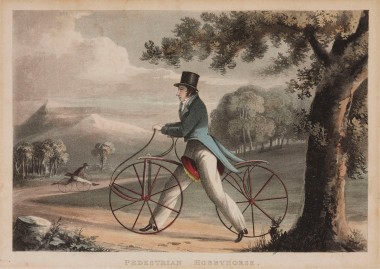
We use images to share the etymological journey of with the children. We want them mostly to understand that <cycle> derives indirectly from Greek kyklos.
We ask:“What do you notice?”
The children ask about the spelling of <k> in the Greek word. We show how the word is spelled in Greek κύκλος. We talk about how a medial <k> in a modern day English base element is a reliable sign that the word has derived from Greek.
On another day we share the story of Cyclops, literally ‘round eyed’. The children have discovered the story in the library and of course they wish to know more.

How is it Built?
We return to the selection of words we have hypothesized sharing the free base element <cycle>. We model the assembly of the word sum, announcing aloud the written elements, pausing at the morphemic boundaries and announcing any suffixing changes. We find evidence of the elements we have constructed.
“c-y-c-l-final non syllabic <e>… ing … is rewritten as c-y-c-l-replace the<e> … ing, cycling”
The simultaneous actions of writing and announcing aloud ensures the internalization of all the elements.
As we construct the matrix the children assemble the word sum on small white boards or in their word inquiry journals.
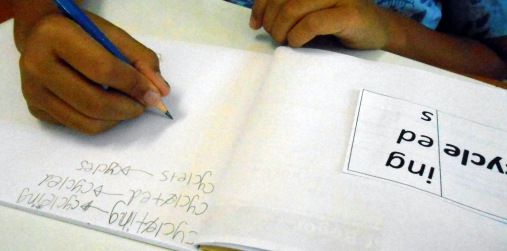
We write the word sum for each complex word before we add further elements to the matrix. We continually refer to the word-web to select words to place on the matrix.

We do this over a period of time, throughout the day, during the week, focusing on one or two word sums at a time. The children take their matrix home to share with their family. We continue to explore the subtle differences between each word that share the free base element <cycle>.
Some of the children choose to add to their matrix and build further words.
Simultaneously we continue our deep study of cycles in nature and we decide to focus on the cycle of day and night to appreciate and realise the motion of the earth orbiting the sun.
Phonology
With our knowledge of the morphology and etymology well embedded, we embark on a study of the phonology of <c>, to investigate the significant graphemes and phonemes that bring further sense and meaning.
We know that morphology and etymology drive phonology and therefore we can only investigate a word’s phonology within the domains of morphology and etymology.
The phonology of the free base element:
4 graphemes <c> <y> <c> <l>
the single, final, non syllabic <e>
4 phonemes /s/ /aɪ/ /k/ /l/
As we hoped, the children are questioning and discussing the different functions of the single letter grapheme in the initial and medial positions of <cycle>.
It is necessary for the children to understand:
- the same grapheme can and will represent different phonemes and
- the same phoneme can be represented by different graphemes.
The orthography of <c> provides the relevant learning opportunity to deepen these critical phonological principles. We study and analyse the single letter grapheme <c> which can represent two different phonemes /s/ and /k/.
The linguistic terminology: grapheme, phoneme, IPA, angle brackets and slash brackets naturally occur in our everyday discourse.
As with all our quests, we need to ensure the learning community understands the meaning of the words we will use to analyse phonologically.
The children take part in the trading game to communicate the meaning of their word. The children trade words and move to another partner.
Through this collaborative task the children encounter many words, building and deepening their personal lexicon. We deliberately partner ourselves with children who need support to understand their initial word. After this the children support each other.

The children collaboratively illustrate the words and return the words to the word bag.
During the next encounter the children select a word from the word bag and identify the position of the grapheme in their word. We discuss the circumstances of this grapheme: initial, medial or final?

We guide the children through a concept attainment quest. The children place their word on the Venn diagram as directed by us. Their role is to think about our thinking.
“Why did I ask you to place your word in the red circle or the blue circle or the overlapping part?”
“How interesting that cycle and circle are placed in the overlap!”
We revisit the phonological analysis over a number of days so the children have time to ponder on the placement of the words.
When we reconvene as a group the children discuss and share their hypotheses.
We decide as a learning community that the single letter grapheme is representing either /s/ or /k/ or both in the case of circle and cycle.
During the next weeks we revisit the phonology of <c> so that the children develop their understanding of grapheme choices. We encourage the children to add other words to the growing collection as they encounter them in books or when writing.
We revisit the vowel letters and learn how to script the pathways of each letter. The children especially enjoy scripting the beautiful ligature of the vowel letter < y>.
We plant further phonological ‘learning seeds’ so the children will encounter other phonemes represented by the single letter grapheme; or other graphemes that represent the phoneme /k/.

Questions?
We are left with many questions as we continue our orthographic study.
Throughout our quest we read and revisit Jeannie Baker’s stunning literary text Circle.
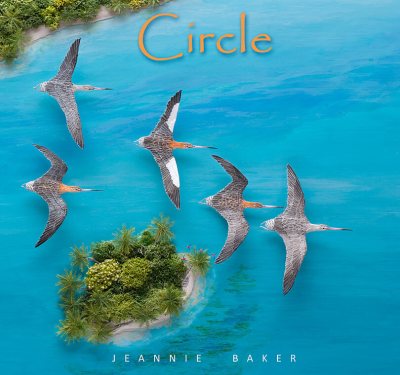
We wonder why the author has chosen the title Circle.
We feel and see the cyclic nature of the bar-tailed godwit’s annual journey in the text.
“Why not cycle?”
We wonder about cycle and circle.
“Are they etymologically related?”
We would like them to be related, but we know we need to provide evidence…

This study is an ebb and flow, a cycle, it’s cyclical, we are continually returning to our quest to deepen our learning and those of our students.

Migration:
When working with students or teachers, before leaping to resources, we first try to get our own sense of the word.
What is migration? What is migration not?
Often in determining what something is not, our understanding of what that ‘something’ is will deepen.
Migration is not staying still, staying put. Migration is not a recent phenomena, nor applicable to humans only.
Migration is a movement. It involves a journey, a change. Migration is innate in some species and becomes part of an annual pattern involving a change of location, predictable and seasonal. Migration is cyclical.
‘They follow an ancient invisible pathway for six nights and six days, until they know they need to stop’ (Baker).
The Morphological Family
Migration
Asking students to decide which words may be or may not be in a family is one way to identify a common base element.

Examining this set of words, developing a hypothesis with word sums to confirm a base element, leads to lively discussion. Rejecting words like fumigate, migraine and mighty is critical. On the surface they share a letter string <mig> but this carries no meaning; it is not a base element in any of the words. These words do not share a common sense found beneath migrant, emigrate, immigrant and transmigratory.
If we analyze immigrant as <im +migr+ant>, then we need to justify our hypothesis.
What other words can confirm the presence of these elements?
“What other words share the prefix <im-> ?”
“Import, imprecise, immature.”
“What other words confirm the presence of <-ant> as a suffix?”
“Important: <im+port+ant>, hydrant: <hydr+ant>, pleasant: <please+ant>.”

At this stage we draw on our collective knowledge – we do not rush to resources or “google” it. Rather we think and confirm with word sums to develop our hypothesis that <migr> is the common bound base element.
Migration is built of three elements: the bound base element <migr> and the suffixes <-ate> and <-ion> so <migr+ate+ion >.
We notice that the vowel suffix <-ion> removes a final, non-syllabic <e>. This is a key suffixing convention that occurs in many words and should be an explicit inquiry. We maintain a growing collection of vowel and consonant suffixes and any new discoveries are placed carefully.

It is only the vowel suffix that has the potential to either double a final consonant letter or replace the final non-syllabic <e>.

Gathering the relatives in a word-web allows us to find members of the family and recognize the underlying meaning connection.
Word-webs that are assembled grow slowly over a week or they can be constructed in a single class session. They can be sent home and discussed with the family and new discoveries that share the base <migr> can be added. We have seen large word-webs posted in school corridors or the library where anyone with a suggestion of an additional related word can contribute.”

A matrix is a powerful morphological portrait of the family. We note the base element is bolded. It is the main meaning carrying element present in every word – its morphological heart. The denotation of the base element beats beneath every word in the family. We are now ready to explore subtle nuances.
What is the difference between emigrate and immigrate?
What is the difference between immigration and immigrant?
The words are analyzed in word sums – the linguistic representation of the elements. We write the word sum enclosed in angle brackets and instigate the synthesis of the elements with the rewrite arrow, announcing any suffixing changes.

We announce the elements, pausing at the morpheme boundary and announce any changes.
“migr … ate … ion is rewritten as migr … ate replace the <e> …ion.”
This helps consolidate conventions and internalizes the elements through the kinesthetics of writing and speaking. Noticing the final suffix often leads to a discussion of the way a word can be used in a sentence.
“Is migration nominal, verbal, adjectival, adverbial? How do you know?
Etymological Relatives
Stories are made of words and every word has a story.
Migration, attested in 1610, referred only to people. In the 1640s it broadened to include animals. It is derived from Latin migrare “to move from one place to another,” ultimately traced back 5,500 years to a Proto Indo European root *mei-(1) “to change, go, move”.
The knowledge of birds migrating to Asia was recognized in the Middle Ages, but faded later. Even the remarkable scholar Dr Johnson, while admitting to Boswell in 1768 that woodcocks migrate, claimed :
‘Swallows do certainly sleep all winter. They conglobulate together by flying round and round and then, all in a heap, throwing themselves under water.”’
This was more plausible than the fanciful assertion by the naturalist Morton (1703) who proposed a theory that swallows ‘migrated to the moon’.
As late as 1837 bird migration was not widely understood. The Online Etymology Dictionary tells of the Kendal Mercury reporting
‘… a person having observed several Swallows emerging from Grasmere Lake, in the spring of that year, in the form of ‘bell-shaped bubbles,’ from each of which a Swallow burst forth ….’

We notice that this ancient root, P.I.E.* mei-(1), has produced distant etymological relatives such as mutation, moult and mews. The underlying sense of ‘change’ is apparent in mutation and moult but less so in mew until you dig beneath the surface.
Mew entered English in 1300 from Old French mue and the verb muer to molt. A mew was the cage or place for falcons to moult. Today the rather expensive mews properties in London have disguised their feathery, raptor origins in trendiness and high prices.
We of course wonder about the etymology of Baker’s feathery protagonists, the godwits.

Our research takes us to the OED where we find that godwit was attested in 1416-17 and was ‘probably originally imitative of the bird’s call’ (OED). An alternative name for the godwit was yarwhelp used from 1577. This name too was:
‘imitative of the goat-like cry of the godwit’.
Alarmingly, the hapless godwit was frequently eaten:
‘Godwyts..accounted the daintiest dish in England; and, I think, for the bigness, of the biggest price.’ (Sir T. Browne in 1682)
Today it’s a not the threat of being eaten that plagues the intrepid godwit but loss of habitat.

Godwit Migration
Our word inquiry and the book Circle spurs us to uncover more about godwit migration.
We discover that:
- the north-bound godwit migration, is over 10,000 km, accomplished in two stages.
- the godwits shrink their gizzards and intestines in August so they can fly south on their accrued fat reserves.
- the godwit completes the southern bound journey from Alaska to New Zealand, a distance of 11,500 km., non-stop in just over eight days.

‘Late one afternoon, when the wind is icy, godwits call to each other. The time is right. Suddenly they leave as one. Following an ancient, invisible pathway high above the clouds, each bird takes a turn to lead the way south.’ (Baker)
The migratory cycle of the godwit told so eloquently in Baker’s Circle is just one species involving many bird migrations that move through global flyways in a rhythm tied with feeding and breeding, with seasons and light. The cycle, once a certainty, is today increasingly precarious.
We stand firmly on the ground awed by the airy accomplishments of godwits whose continued migratory cycle lies in our hands.

And so we circle back to Jeannie Baker’s Circle: ‘back in the place where mud and sand become sea.’
This text has sparked orthographic inquiry with both older and very young students.
We return to the words cycle and migration with a heightened understanding of the orthography within the domains of morphology, etymology and phonology. These are interrelated and cyclical.
Our selected words are intentionally few and integral to the text.
Understanding these words reveal important orthographic principles and conventions that underlie all words.
“Birds were flying from continent to continent long before we were. They reached the coldest place on Earth, Antarctica, long before we did. They can survive in the hottest of deserts. Some can remain on the wing for years at a time. They can girdle the globe. Now, we have taken over the earth and the sea and the sky, but with skill and care and knowledge, we can ensure that there is still a place on Earth for birds in all their beauty and variety — if we want to… And surely, we should.”
– Sir David Attenborough, The Life of Birds




































